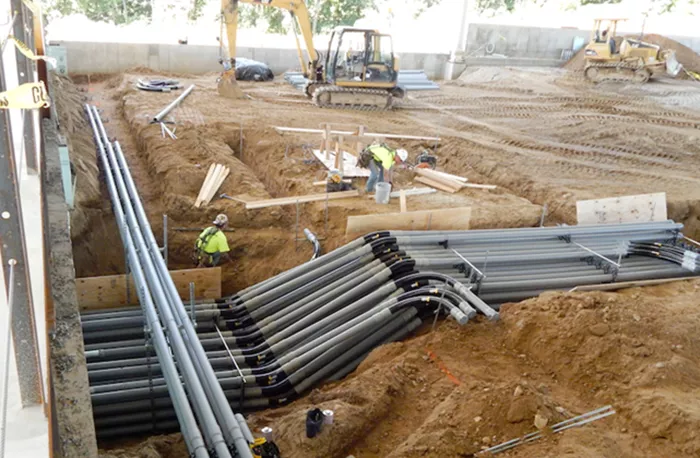Properly burying electrical conduit is crucial for ensuring the safety, functionality, and longevity of your electrical system. The depth at which you bury conduit depends on various factors, including the type of conduit, the location, and local regulations. Here’s a comprehensive guide to help you understand how deep to bury electrical conduit for different applications and conditions.
Understanding Electrical Conduit
Types of Electrical Conduit
PVC Conduit: This plastic conduit is commonly used for residential and light commercial applications due to its resistance to corrosion and ease of installation. It is often used in underground settings because of its flexibility and durability.
Rigid Metal Conduit (RMC): Made of galvanized steel or aluminum, RMC is known for its strength and is used in more demanding environments. It provides excellent protection against physical damage but is more challenging to work with compared to PVC.
Intermediate Metal Conduit (IMC): IMC is a thinner version of RMC, offering similar protection but with less weight. It is often used in commercial settings where space and weight are concerns.
Electrical Metallic Tubing (EMT): EMT is a lightweight, thin-walled conduit used for above-ground applications. While it is less durable than RMC or IMC, it is still suitable for certain underground applications when properly protected.
Purpose of Burying Electrical Conduit
Burying electrical conduit protects the electrical wiring from physical damage, environmental factors, and potential interference. Proper burial depth ensures that the conduit is shielded from external forces and remains functional over time.
Recommended Burial Depths
General Guidelines
The National Electrical Code (NEC) provides general guidelines for conduit burial depths. However, local codes and regulations may vary, so always check with your local authorities before proceeding.
PVC Conduit
Residential Areas: The standard depth for PVC conduit in residential areas is typically 18 inches. This depth provides adequate protection against physical damage and is sufficient for most residential applications.
High Traffic Areas: In areas where the conduit might be subjected to heavy traffic or potential damage (e.g., driveways or roads), the recommended depth is often increased to 24 inches. This additional depth helps protect the conduit from impacts and other hazards.
Rigid Metal Conduit (RMC) and Intermediate Metal Conduit (IMC)
Residential and Commercial Areas: RMC and IMC can generally be buried at a depth of 6 to 18 inches in residential areas. For commercial or high-traffic areas, a depth of 18 to 24 inches is recommended to ensure added protection.
Special Conditions: In some cases, where the conduit is subject to heavy loads or potential damage, deeper burial may be required. Consult local codes for specific requirements.
Electrical Metallic Tubing (EMT)
Residential Use: EMT is less commonly used for underground applications due to its thinner walls. When used, it typically requires a minimum burial depth of 18 inches. It is crucial to ensure that the conduit is adequately protected against physical damage, as EMT is more susceptible to impacts.
See also: What Is A Brad Nailer Used For?
Factors Affecting Burial Depth
Local Codes and Regulations
Local building codes and regulations can vary significantly. It is essential to consult your local electrical code or building authority to determine the specific burial depth requirements for your area. Compliance with local codes ensures safety and avoids potential legal issues.
Soil Conditions
Soil conditions can impact the required burial depth. In areas with rocky or unstable soil, additional depth may be necessary to ensure that the conduit remains properly protected. Conversely, in loose or sandy soil, a shallower depth might be acceptable, provided the conduit is adequately supported and protected.
Traffic and Load Conditions
Areas subjected to heavy traffic or significant loads (e.g., driveways, roads, or areas with frequent vehicle movement) generally require deeper burial depths to protect the conduit from physical damage. Consider the expected load conditions when determining the appropriate depth.
Conduit Protection
In some cases, additional protection may be required for the conduit, such as concrete encasement or protective sleeves. This is particularly relevant in areas where the conduit is exposed to potential damage or harsh environmental conditions.
Installation Tips
Preparing the Trench
Before installing the conduit, ensure that the trench is properly prepared. The trench should be wide enough to accommodate the conduit and provide space for backfilling. The bottom of the trench should be smooth and free of sharp objects that could damage the conduit.
Placing the Conduit
Carefully place the conduit in the trench, ensuring that it is properly aligned and supported. Avoid sharp bends or kinks in the conduit, as these can impede the installation of wiring and affect performance.
Backfilling and Compaction
After placing the conduit, backfill the trench with soil, ensuring that the conduit is adequately covered. Compact the soil to prevent settling and maintain proper depth. Avoid using heavy machinery or equipment directly over the trench until the soil is fully compacted.
Conclusion
Properly burying electrical conduit is essential for protecting your electrical system and ensuring long-term reliability. Understanding the recommended burial depths for different types of conduit, considering local codes and regulations, and accounting for factors such as soil conditions and traffic loads will help you achieve a safe and effective installation. By following these guidelines and consulting with local authorities, you can ensure that your electrical conduit is buried at the appropriate depth, providing the necessary protection and functionality for your electrical system.
Related Topics:

